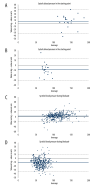Evaluation of Neuromuscular Blockade: A Comparative Study of TOF-Cuff® on the Lower Leg and TOF-Scan® on the Ulnar Nerve During Mivacurium Anesthesia
- PMID: 39397356
- PMCID: PMC11488455
- DOI: 10.12659/MSM.945227
Evaluation of Neuromuscular Blockade: A Comparative Study of TOF-Cuff® on the Lower Leg and TOF-Scan® on the Ulnar Nerve During Mivacurium Anesthesia
Abstract
BACKGROUND To evaluate neuromuscular monitoring during anesthesia with mivacurium, this study assessed the correlation between measurements of TOF-Cuff® placed on the lower leg and stimulating the tibial nerve and TOF-Scan® values from the adductor pollicis muscle. Additionally, systolic (SBP) and diastolic (DBO) blood pressure measured in both locations were compared. MATERIAL AND METHODS Twenty-six patients participated in this observational clinical trial. The TOF-Cuff® was placed on the lower leg and the TOF-Scan® was placed on the thumb. Train-of-four (TOF) values were recorded simultaneously by both devices at 30-second intervals before intubation. Measurements continued every 5 minutes until extubation. Bland-Altman analyses compared TOF values obtained from the 2 devices. RESULTS Time to onset and relaxation time did not differ significantly; the number of patients presenting a lack of blockade despite TOF=0 was also concordant. The time from the last dose of mivacurium to TOF ratio >90 was shorter on the leg than on hand (median 20 [5-28, 0-65] min vs 30 [20-35, 0-60] min, p=0.025). The median (range, interquartile range) difference between measurements was: 11.6 (-41 to 45, 2-19) for SBP and -8 (-28 to 26, -15 to -4) for DBP at baseline (p=0.0495); 5 (-53 to 55, -2 to 9) for SBP and -11 (-45 to 29, -19 to -5) (p=0.0017) for DBP during the blockade. CONCLUSIONS Time-to-onset and SBP are comparable between these 2 methods, in contrast to time-to-recovery and diastolic blood pressure, and this should be considered in case of the inability to apply the TOF-Cuff on the leg.
Conflict of interest statement
Figures




Similar articles
-
Comparison of TOF scan neuromuscular monitoring on adductor pollicis vs. corrugator supercilii and flexor hallucis brevis.Sci Rep. 2025 Jul 14;15(1):25426. doi: 10.1038/s41598-025-11259-5. Sci Rep. 2025. PMID: 40659829 Free PMC article.
-
Comparison of measurements obtained with TOF-Cuff placed on the arm and the TOF-Scan on the adductor pollicis muscle during general anaesthesia using mivacurium: a prospective observational clinical trial.Sci Rep. 2024 Nov 8;14(1):27180. doi: 10.1038/s41598-024-76086-6. Sci Rep. 2024. PMID: 39516501 Free PMC article. Clinical Trial.
-
Comparing Neuromuscular Blockade Measurement Between Upper Arm (TOF Cuff®) and Eyelid (TOF Scan®) Using Mivacurium during General Anesthesia.Med Sci Monit. 2024 May 2;30:e943630. doi: 10.12659/MSM.943630. Med Sci Monit. 2024. PMID: 38693676 Free PMC article.
-
Placement of TOF-Cuff® on the lower leg for neuromuscular and blood pressure monitoring during anesthetic induction for shoulder surgeries.J Anesth. 2020 Feb;34(1):79-85. doi: 10.1007/s00540-019-02712-7. Epub 2019 Nov 23. J Anesth. 2020. PMID: 31760477 Free PMC article.
-
A comparison of the neuromuscular blocking effects of atracurium, mivacurium, and vecuronium on the adductor pollicis and the orbicularis oculi muscle in humans.Anesth Analg. 1996 Oct;83(4):808-13. doi: 10.1097/00000539-199610000-00027. Anesth Analg. 1996. PMID: 8831326 Clinical Trial.
Cited by
-
Neuromuscular Blocking Agents and Reversal Agents Usage, and Neuromuscular Blockade Monitoring in the Intensive Care Unit - Review Article.Int J Gen Med. 2025 Jul 4;18:3651-3688. doi: 10.2147/IJGM.S524089. eCollection 2025. Int J Gen Med. 2025. PMID: 40636288 Free PMC article. Review.
-
Advances in Neuromuscular Monitoring Techniques in Anesthesiology: A 2025 Perspective.Med Sci Monit. 2025 Jul 20;31:e948980. doi: 10.12659/MSM.948980. Med Sci Monit. 2025. PMID: 40684254 Free PMC article. Review.
-
Comparison of TOF scan neuromuscular monitoring on adductor pollicis vs. corrugator supercilii and flexor hallucis brevis.Sci Rep. 2025 Jul 14;15(1):25426. doi: 10.1038/s41598-025-11259-5. Sci Rep. 2025. PMID: 40659829 Free PMC article.
-
Skeletal Muscle Relaxants and Their Impact on Intracranial Pressure in Neurosurgery.Med Sci Monit. 2025 Jan 3;31:e946569. doi: 10.12659/MSM.946569. Med Sci Monit. 2025. PMID: 39748489 Free PMC article. Review.
References
-
- Markle A, Graf N, Horn K, et al. Neuromuscular monitoring using TOF-Cuff® versus TOF-Scan®: An observational study under clinical anesthesia conditions. Minerva Anestesiol. 2020;86(7):704–11. - PubMed
-
- Iwasaki H, Nemes R, Brull SJ, et al. Quantitative neuromuscular monitoring: Current devices, new technological advances, and use in clinical practice. Curr Anesthesiol Rep. 2018;8:134–44.
-
- Murphy GS. Neuromuscular monitoring in the perioperative period. Anesth Analg. 2018;126(2):464–68. - PubMed
-
- Markle A, Graf N, Horn K, et al. Neuromuscular monitoring using TOF-Cuff® versus TOF-Scan®: An observational study under clinical anesthesia conditions. Minerva Anestesiol. 2020;86(7):704–11. - PubMed
Publication types
MeSH terms
Substances
LinkOut - more resources
Full Text Sources

